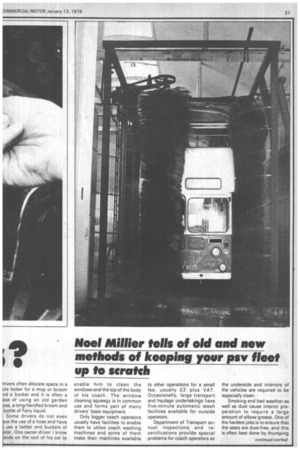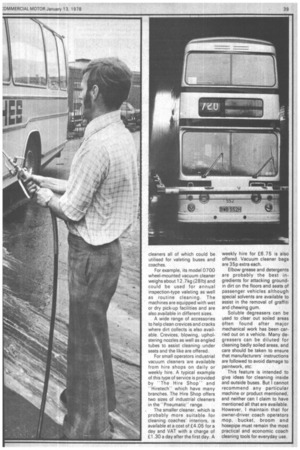Anyone for tem
Page 38

Page 39

Page 40

Page 41

If you've noticed an error in this article please click here to report it so we can fix it.
KEEPING vehicles clean is a constant problem facing both large and small bus and coach operators.
A recent action by South Yorkshire police who took South Yorkshire PTE buses off the road highlights the problems.
Operators of psv are obliged by the Road Traffic Act to clean the windows and seats. But winter days when passengers are wet and roads are filthy make it practically impossible to keep buses clean all the time.
Most large bus operators like the South Yorkshire PTE automatically wash each bus every evening after if finishes its spell of duty. Chaos would be caused if buses had to be washed more than once a day during bad weather, so clearly discretion ought to be exercised by DTp officials and the police. Buses should be allowed to be as clean as conditions allow.
Bus operators in the main use automatic washing machines through which each bus is driven as a matter of routine after it is fuelled and watered on returning to its garage. Cleaners are employed usually to sweE and mop out buses nightly. Small coach operators oftE leave vehicle cleaning to driver
Above left: Still the best method cleaning the seats is beating the with a tennis racket.
Above right: A Merseyside PAtlantean being cleaned by Smi Bros and Webb Streamline vvashi machine.
Irivers often allocate space in a de locker for a mop or broom nd a bucket and it is often a ase of using an old garden ose, a long-handled broom and bottle of Fairy liquid.
Some drivers do not even aye the use of a hose and have use a ladder and buckets of ater. One owner-driver I know ands on the roof of his car to enable him to clean the windows and the top of the body of his coach. The window cleaning squeegy is in common use and forms part of many drivers' basic equipment.
Only bigger coach operators usually have facilities to enable them to utilize coach washing machines and some of them make their machines available to other operations for a small fee, usually £2 plus VAT. Occasionally, large transport and haulage undertakings have five-minute automatic wash facilities available for outside operators.
Department of Transport annual inspections and recertifications provide special problems for coach operators as the underside and interiors of the vehicles are required to be especially clean.
Smoking and bad weather as well as dust cause interior preparation to require a large amount of elbow grease. One of the hardest jobs is to ensure that the seats are dust-free, and this is often best done by thumping them with an old tennis racket or a length of rubber hose.
Once this operation is completed an industrial vacuum cleaner can be brought in to clean up the dust and prepare the inside for scrubbing, which is probably one of the most time-consuming and gruelling jobs of all.
Liquid Ajax with ammonia is probably as good as any cleaner for removing ground-in dirt and nicotine stains from floors and roof-linings.
Among the most popular manufacturers of automatic bus washing equipment are AVM Wilcomatic and Smith Bros. and Webb, Pryocleanse, Esquire, and Kleindienst.
Merseyside PTE is at present replacing its semi-automatic vehicle washing equipment with new fully automatic "streamline" washing machines.
The "streamlinewashing machine, built by Smith Bros and Webb, basically consists of a pre-rinse section, two sets of rotating brushes and pneumatically operated arms and a fine rinse section. One of its operational features is that its brush configuration provides a -wrap-roundaction which thoroughly cleans front and back and double cleans the sides of buses. It also incorporates a "roof blanketfor cleaning bus tops.
Each streamline installation can handle up to 60 buses an hour. Any size of bus or coach can be washed by the £20,000 machines, which are complete with a recirculating water plant.
Fitting fully automatic bus washing plant in bus garages obviates the need to use manual washers in garages to wash the back and front of buses — each installation shculd pay for itself, in saved labour costs, in five years.
Washing machines should be carefully installed on a smooth base to avoid causing damage to vehicles' bodies and fittings during the washing process.
As well as fully automatic machines, some machines, where the back and front of the vehicle has to be washed separately, have moving gantry systems where the washing equipment moves round the stationary bus; others have moving frame systems, where the washing equipment is low ered and raised around the stationary bus. Portable pressure machines are also available — they are basically a portable pump and a pressure hose.
For operators who have neither the facilities nor the inclination to prepare coaches to the high standard of cleanliness required for the sale of vehicles, for recertification or annual Ministry inspecion, a coach valeting service is available from Servicemaster Ltd.
Servicemaster specializes in upholstery clearning and has branches nationwide. Each job undertaken is quoted on its merits and prices can range anywhere between £20 and £100.
Heavy industrial vacuum cleaners needed for finally cleaning the dust left in coach and bus interiors after upholstery cleaning can be bought in or hired from companies such as Vacmobile, of Harrow, Middlesex.
Vacmobiles' industrial vacuum cleaner division has for a number of years specialised in manufacturing high-power industrial and commercial vacuum cleaners. Vacmobile's basic range consists of five cleaners all of which could be utilised for valeting buses and coaches.
For example, its model 0700 wheel-mounted vacuum cleaner weighs about 12.7kg (281b) and could be used for annual inspection-type valeting as well as routine cleaning. The machines are equipped with wet or dry pick-up facilities and are also available in different sizes.
A wide range of accessories to help clean crevices and cracks where dirt collects is also available. Crevices, blowing, upholstering nozzles as well as angled tubes to assist cleaning under seats and the like are offered.
For small operators industrial vacuum cleaners are available from hire shops on daily or weekly hire. A typical example of this type of service is provided by "The Hire Shop— and "Hiretech" which have many branches. The Hire Shop offers two sizes of industrial cleaners in the "Pneumatic— range.
The smaller cleaner, which is probably more suitable for cleaning coaches' interiors, is available at a cost of £4.05 for a day and VAT with a charge of E1.30 a day after the first day. A weekly hire for £6.75 is also offered. Vacuum cleaner bags are 35p extra each.
Elbow grease and detergents are probably the best ingredients for attacking groundin dirt on the floors and seats of passenger vehicles although special solvents are available to assist in the removal of graffiti and chewing gum.
Soluble degreasers can be used to clear out soiled areas often found after major mechanical work has been carried out on a vehicle. Many degreasers can be diluted for cleaning badly soiled areas, and care should be taken to ensure that manufacturers' instructions are followed to avoid damage to paintwork, etc.
This feature is intended to give ideas for cleaning inside and outside buses. But I cannot recommend any particular machine or product mentioned, and neither can I claim to have mentioned all that are available. However, I maintain that for owner-driver coach operators mop, bucket, b-room and hosepipe must remain the most practical and economic coach cleaning tools for everyday use.




























































































